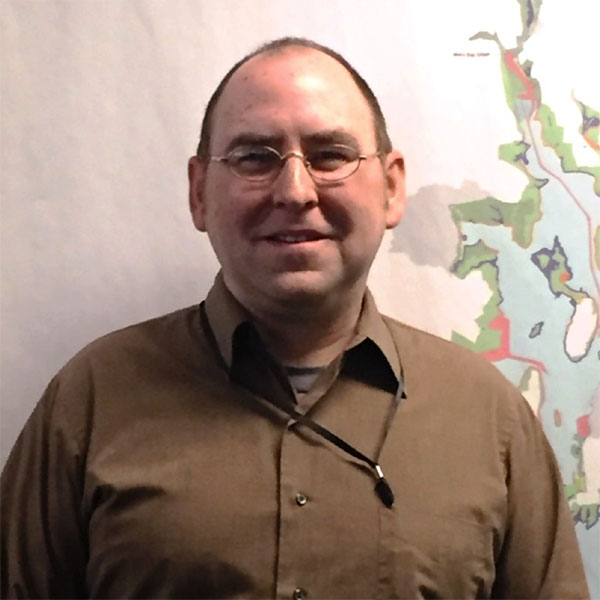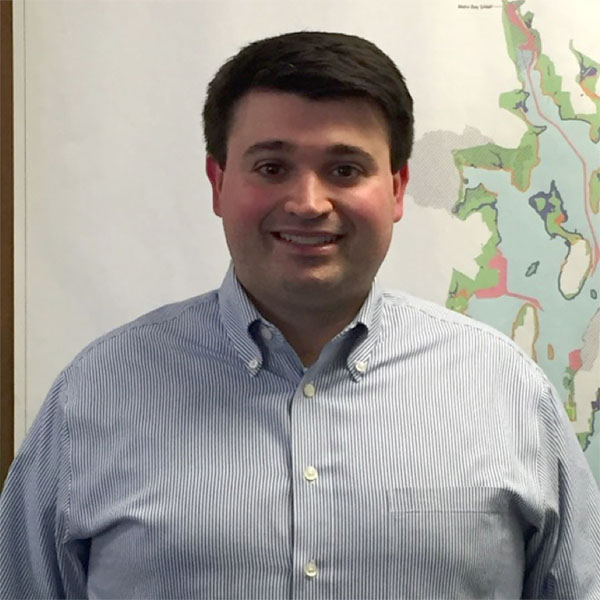
RI Coastal Resources Management Council
...to preserve, protect, develop, and restore coastal resources for all Rhode Islanders

...to preserve, protect, develop, and restore coastal resources for all Rhode Islanders
CRMC hires two new ocean engineers
February 14, 2019, WAKEFIELD – The Rhode Island Coastal Resources Management Council (CRMC) has hired engineers to fill two newly created ocean engineering positions within the agency.
David Ciochetto, an aerospace and ocean engineer, and Justin Skenyon, an ocean engineer, joined the staff in January. Skenyon will be largely focusing his efforts on the complicated wind energy permitting projects before the CRMC, while Ciochetto will be rounding out the permit staff, as well as working on wind energy projects.

David Ciochetto

Justin Skenyon
The CRMC has operated without a full complement of engineers for more than three years, after two of its longtime staff retired. Ciochetto, who graduated first from Boston University and then Virginia Polytechnic Institute, has worked over the last 20 years in academia, including Michigan Technological University where he worked in the physics department; Woods Hole Oceanographic Institution where he served as engineering and operations support for physical oceanographic field and laboratory research; Dalhousie University in Nova Scotia; and Virginia Tech.
“CRMC is one of the few organizations that not only acknowledges Earth’s climate is changing, but has actually taken proactive steps to plan for Rhode Island’s future,” he said, when asked what most appealed to him about working for the Council. “The CRMC is on the leading edge of mitigating humanity’s risk to climate change. Grover Fugate, the executive director, and CRMC have been internationally recognized as leaders in science-based policy, and to be given an opportunity to serve the people of Rhode Island and to merge my experience with that of CRMC in a role that benefits our children’s future is an honor.”
For Ciochetto, who has spent more than 300 days on blue water expeditions – which can last 24 to 56 days without land in sight – as well as an avid yacht racer, working on and with the ocean has taught him lifelong lessons.
“The ocean teaches you to both fear and respect our planet,” he said. “My time in this environment has taught me that even when you think you understand something, you are bound to witness the unexpected.”
While Ciochetto’s expertise is engineering, oceanography, atmospheric science, and the physics of fluid dynamics and its measurement, he admits to having a keen interest in renewable energy development. In 2007, he proposed a comprehensive renewable energy structure plan to Liberia’s ministry of energy. The plan included an economic structure, establishment of educational expertise and plans to support the industry in scalable stages through a manufacturing base.
At Michigan Technological University, Ciochetto was the lead research engineer and director of operations on a project to build the only cloud chamber in the world capable of sustaining cloud drops for more than 12 minutes. At the end of his time there, Ciochetto had created a cloud that lasted for more than a month continuously. All of his time in academia, Ciochetto said, has prepared him well for policy and permitting work at the CRMC.
“I have been on all the S.T.E.M. sides of issues relevant to Rhode Island’s coastal resources,” he said. “The biggest thing that I can bring to the community is complimentary experience that the wind developers and engineers may not be considering in the coastal environment. I can see things from many angles, and have one leg ‘in the box’ and one leg ‘outside of the box.’ I can see things from the ocean perspective and the engineering perspective, and may be able to proactively help develop the offshore wind resources to mitigate future impacts.”
Justin Skenyon graduated from the University of Rhode Island with a Bachelor’s in ocean engineering and a focus in underwater archaeology. Previous to his start at the CRMC, Skenyon worked for three years for Navetek, Ltd., developing early stage ship design software and methods for the computation of ship stabilization. During his time at URI he also worked on a coastal construction and engineering proposal to address beach erosion, on a study of the acoustics and frequency of the Newport Bridge, as well as Nautilus Live under the direction of Dr. Robert Ballard, and with the U.S. Environmental Protection Agency studying marsh erosion.
At the EPA, Skenyon worked as a lab assistant, collecting field samples, doing analysis of magnetic resonance imaging, and compiled the data. The purpose of this work was to determine how the root systems of different marsh ferns can contribute to their survival in the tidal zone. Skenyon said this work has contributed to his understanding and ability to interpret technical data and forecast future trends.
As a lifelong Rhode Islander who now lives in a coastal community, Skenyon said he’s always been fascinated with the coastal environment. Working at the CRMC, he added, will allow Skenyon to utilize his technical skills toward his interest in making a difference and contributing to the CRMC’s endeavors and accomplishments.
“I was drawn to CRMC to have an impact on our coastal environment through its measured approach and advocacy to address the problems we face today,” he said. “I have also always been fascinated with the impact the ocean has on a community and the whole state. I chose to study ocean engineering to better understand how we can work to prepare to protect our coast and plan for projected sea level rise. I bring a passion for policy and am honored to be working with the CRMC and its staff to further its mission.”